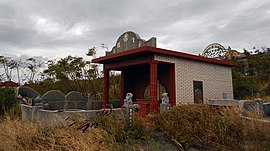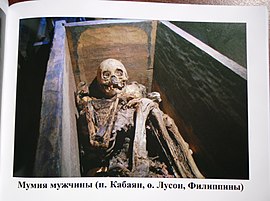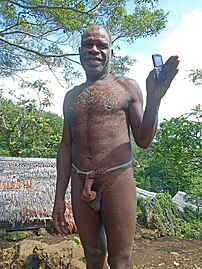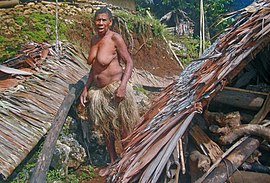Hobo tourism/Viktor Pinchuk's expedition to the Islands of Oceania


The expedition to the islands of Oceania is a project of the Russian traveler Viktor Pinchuk, where the goal was to explore places rarely visited by travelers. The most notable part of the route is the ethnic village of Bunlap on the Pentecost Island, inhabited by aboriginal people who have retained ancestral traditions.
General information
[edit | edit source]- Duration: 2,5 months.
- Period: 15. 12. 2018 — 09. 03. 2019.
- Idea: Viktor Pinchuk.
- Number of participants: 1 (one).
- Transit through: Irkutsk.
- Starting point: Incheon International Airport (Seoul, South Korea).
- Number of countries visited: 8 (eight), including 20 Islands.
- Way to get: plane.
- Ways to move: air transport, land transport, water transport, pedestrian routes.
- Nature of the journey: creative trip.
- Purpose: to learn about the Aboriginal way of life, preparing material for a book
- Format: standard hobo tour, bum tour.
Places visited
[edit | edit source]- South Korea (Korean Peninsula, islands: Ganghwado, Seongmodo, Yeong-do, Jodo). Localities: Seoul, Suwon, Sokcho, Busan.
- Taiwan. Localities: Taipei, Hualien City, Fangliao, Hengchun.
- Philippines (islands: Cebu, Palawan, Luzon, Cadlao, Miniloc). Localities: Mandaue, Liloan, Cebu City, Badian, Puerto Princesa, El Nido, Angeles, Vigan, Tagudin, Baguio, Kabayan, Manila.
- Singapore (main island, Sentosa Island).
- Fiji (Viti Levu Island). Localities: Nadi, Lautoka.
- Vanuatu (islands: Efate, Pentecost). Localities: Port Vila, Pango, Saama, Bayhemu, Ranwas, Ratap, Bunlap, Wali.
- Tonga (islands: Tongatapu, ʻEua). Localities: Nuku'alofa,'Ohonua, Lapaha.
- Samoa (islands: Upolu, Savaiʻi, Manono). Localities: Apia, Lotofaga, Vaisala, Falealupo, Vaipua, Taga, Palauli, Gautavai, Satupaitea.
The methods applied
[edit | edit source]In the process of moving along the route the following accommodation options were used:
- In hostels — in South Korea, Taiwan, Singapore, Fiji, Tonga, Samoa.
- At the cemetery — near Fangliao, Taiwan.
- In Aboriginal dwellings — in Ranwas village and a detached hut between Beimu and Wali on Pentecost Island, Vanuatu.
- On the coast of the ocean, in jungle thickets — in El Nido on Palawan and Badian on Cebu (Philippines); on Eua; in Vaisala village on Savaii (Samoa),
- On objects under construction — in Vigan & Baguio (Philippines)
- In low-cost accommodation — in the Philippines.
- In abandoned buildings — in Port Vila (Vanuatu), on the island of ʻEua (Tonga).
- In a one-and-a-half-metre security booth at the entrance to airport of of Puerto Princesa (Philippines).
- On the floor of a railway terminal in Hualien City, Taiwan.
- On the floor of seaport terminal, Savaiʻi Island (Samoa).
- In the lounges of international airports: Nadi (Fiji) and Faleolo (Samoa).
Outcomes and results
[edit | edit source]— Collected visual historical and geographical information:
- about the oldest mound in Polynesia, Pulemelei, discovered by archaeologists on the island of Savaiʻi in Samoa;
- about the ancient burials on the island of Tongatapu (Tonga), called terraced tombs;
- about the dolmens on Ganghwa Island (South Korea);
- about hanging coffins and caves of mummies in the Philippines.
— A number of articles have been prepared for the Russian Wikipedia illustrated by the author’s photographs, including on the little-known waterfalls of Oceania:
— Based on the materials of the trip written the book "Two months of wandering and 14 days behind bars".
Problems, difficult moments
[edit | edit source]An unforeseen circumstance — deportation by the Fiji authorities with a two-week sentence "under house arrest" — prevented the continuation of the route and completion of the intended.
Quotes
[edit | edit source]"Good place for a overnight staying", — I thought, looking at one of the graves — a crypt with a high stone fence. It is interesting that the photos of the deceased and the dates of their lives are missing. Otherwise, the portrait of the deceased, on whose grave I spent the night, having materialized into an image, could appear in a dream.[1]
Passing the vegetable gardens stretched along the highway, after a few kilometers I noticed a comfortable wasteland and, like a partisan, disappeared into the bushes. «The main thing is not to rain at night», - thought, pulling out sleeping gear. The inhabitants of the small house were busy celebrating the coming New Year two hundred meters from my sleeping place but noisy cries reached me in a muffled state.[2]
Different information
[edit | edit source]Moving in transit through Irkutsk (from where the solo expedition was taken), the traveler gave lectures in two libraries of the northern city.[3]
Gallery
[edit | edit source]Illustrations from the book "Two months of wandering and 14 days behind bars"
-
Overnight location — cemetery near Fangliao, Taiwan.
-
Bangao Mummy Cave on the island of Luzon, Philippines.
-
An overseas novelty. Bunlap village, Pentecost, Vanuatu.
-
Woman from Bunlap village. Pentecost,
Vanuatu. -
Isn’t this a hotel? An abandoned gatehouse in the jungle on ʻEua Island, Tonga.
References
[edit | edit source]- ↑ Pinchuk, Viktor. Two months of wandering and 14 days behind bars (in Russian). Russia: Brovko. p. 18. ISBN 978-5-9909912-5-5.
- ↑ Pinchuk, Viktor. Two months of wandering and 14 days behind bars (in Russian). Russia: Brovko. p. 23. ISBN 978-5-9909912-5-5.
- ↑ "Native of Simferopol in Irkutsk: cultural mission — Southern Capital: newspaper. — 6.08.2021. — № 30 (1502)". wikimedia.org/wikibooks/ru (in Russian). Retrieved April 23, 2023.




